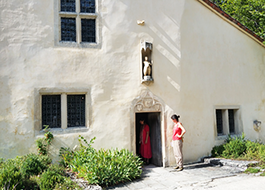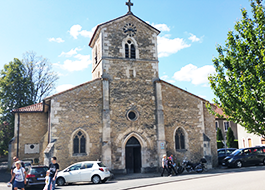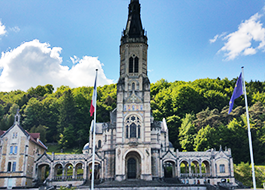Domrémy-la-Pucelle
Durée visite : 110 minutes
Moyen : Pédestre
Le lieu était habité à l’époque celte comme le montrent certaines murailles et tumuli antiques. Au XVe siècle, du vivant de Jeanne d’Arc, la paroisse était divisée en deux parties. L’une dépendait du comté de Champagne, française, l’autre du Barrois mouvant. La jeune Jeanne d’Arc aimait se rendre, pour prier, en la chapelle de Bermont près de Greux. Elle priait également à l’église de Domrémy où elle avait reçu le baptême. Ce sont les voix des saintes Catherine d’Alexandrie, Marguerite d’Antioche et saint Michel Archange qui l’initièrent à sa mission. Domrémy ou du moins la partie Nord, dans laquelle se trouvait la maison de Jeanne d’Arc, fut exempté d’impôts par Charles VII. Il le décida après son couronnement lors de l’anoblissement de Jeanne d’Arc. En 1571, le village de Domrémy fut officiellement rattaché à la Lorraine. Elle perdit ce privilège car le duché de Lorraine relevait du Saint-Empire romain germanique. Il fut rattaché au royaume de France deux siècles plus tard sous Louis XV. La paroisse de Domrémy devint en 1578 Domrémy-la-Pucelle.
The place was inhabited in Celtic times as shown by certain ancient walls and tumuli. In the 15th century, during Joan of Arc’s lifetime, the parish was divided into two parts. One depended on the county of Champagne, French, the other on the moving Barrois. The young Joan of Arc liked to go to the chapel of Bermont near Greux to pray. She also prayed at the church of Domrémy where she had received the baptism. It was the voices of Saints Catherine of Alexandria, Margaret of Antioch and Saint Michael the Archangel who initiated her into her mission. Domrémy or at least the northern part, in which the house of Joan of Arc was located, was exempt from taxes by Charles VII. He decided it after his coronation during the ennobling of Joan of Arc. In 1571, the village of Domrémy was officially attached to Lorraine. She lost this privilege because the Duchy of Lorraine came under the Holy Roman Empire. It was attached to the kingdom of France two centuries later under Louis XV. The parish of Domrémy became in 1578 Domrémy-la-Pucelle.
Der Ort wurde in keltischer Zeit bewohnt, wie bestimmte alte Mauern und Tumuli zeigen. Im 15. Jahrhundert, zu Lebzeiten von Jeanne d’Arc, wurde die Gemeinde in zwei Teile geteilt. Einer hing von der französischen Grafschaft Champagne ab, der andere vom sich bewegenden Barrois. Die junge Jeanne d’Arc ging gern in die Kapelle von Bermont in der Nähe von Greux, um zu beten. Sie betete auch in der Kirche von Domrémy, wo sie die Taufe erhalten hatte. Es waren die Stimmen der Heiligen Katharina von Alexandrien, Margarete von Antiochien und des Erzengels Michael, die sie in ihre Mission einweihten. Domrémy oder zumindest der nördliche Teil, in dem sich das Haus von Jeanne d’Arc befand, war von Karl VII. Steuerfrei. Er entschied es nach seiner Krönung während der Veredelung von Jeanne d’Arc. 1571 wurde das Dorf Domrémy offiziell an Lothringen angeschlossen. Sie verlor dieses Privileg, weil das Herzogtum Lothringen unter das Heilige Römische Reich fiel. Es wurde zwei Jahrhunderte später unter Ludwig XV. Dem Königreich Frankreich angegliedert. Die Gemeinde Domrémy wurde 1578 Domrémy-la-Pucelle.

D’azur à une épée d’argent garnie d’or mise en pal, surmontée d’une couronne et accostée de deux fleurs de lys le tout d’or.
Ce sont les armes de Jeanne d’Arc, native comme chacun sait, de Domremy. Pour marquer l’étymologie de la commune, Pierre Dié Mallet avait ajouté à ce blason un chef de gueules à un Saint Remi d’argent. La commune n’a pas retenu ce dessin et a préféré continuer a utiliser le blason de son illustre héroïne.
Azure to a silver sword garnished with gold set in pale, surmounted by a crown and accosted by two fleur-de-lis all in gold.
These are the arms of Joan of Arc, native as everyone knows, of Domremy. To mark the etymology of the town, Pierre Dié Mallet added to this coat of arms a chief of gules with a Saint Remi of silver. The municipality did not retain this drawing and preferred to continue to use the coat of arms of its illustrious heroine.
Azurblau zu einem silbernen Schwert, garniert mit blassem Gold, überragt von einer Krone und angesprochen von zwei Lilie in Gold.
Dies sind die Arme von Jeanne d’Arc, die, wie jeder weiß, von Domremy stammt. Um die Etymologie der Stadt zu kennzeichnen, fügte Pierre Dié Mallet diesem Wappen einen Häuptling der Gules mit einem Heiligen Remi aus Silber hinzu. Die Gemeinde behielt diese Zeichnung nicht bei und zog es vor, weiterhin das Wappen ihrer berühmten Heldin zu verwenden.

Les habitants et les habitantes de Domrémy-la-Pucelle s’appellent les Domrémois et les Domrémoises.
The inhabitants of Domrémy-la-Pucelle are called the Domrémois and the Domrémoises.
Die Einwohner von Domrémy-la-Pucelle heißen Domrémois und Domrémoises.
Les points de visites
.
Le musée est entièrement consacré aux représentations de Jeanne d’Arc. Se destin tragique n’a cessé d’inspirer écrivains, artistes et historiens depuis plus de deux siècles. La visite du musée est la première étape d’un circuit-découverte du patrimoine de la ville. Il inclue notamment les sites évoquant l’épopée de Jeanne d’Arc. Près de 300 dessins, maquettes, cartons de vitraux, estampes et affiches témoignent de la richesse de l’imagerie johannique. Elle a trouvé logiquement sa place à Vaucouleurs. Son rôle fut capital dans l’épopée de la Pucelle. Jeanne y naquit en janvier 1412. Son père y était laboureur. Paysan aisé, il louait une partie de l’ancien château, disparu depuis lors. On peut visiter sa maison natale. La façade actuelle fut édifiée en 1531 par un arrière petit neveu de Jeanne, Claude du Lys, seigneur de Domremy. Achetée en 1818 par le Département des Vosges et classée Monuments Historique des 1840. La Maison Natale de Jeanne d’Arc a été conservée et restaurée. Sa façade est ornée d’un tympan sculpté d’armoiries du XVe siècle. Une statue de Jeanne en armure agenouillée s’y trouve. A l’intérieur, on peut visiter quatre pièces, la chambre natale, la chambre de Jeanne au fond, le cellier et la chambre des frères.
The museum is entirely devoted to representations of Joan of Arc. His tragic fate has inspired writers, artists and historians for more than two centuries. Visiting the museum is the first stop on a tour of the city’s heritage. It notably includes sites evoking the epic of Joan of Arc. Nearly 300 drawings, models, boxes of stained glass, prints and posters bear witness to the richness of Johannine imagery. It has logically found its place in Vaucouleurs. Her role was essential in the epic of the Maid. Jeanne was born there in January 1412. Her father was a plowman there. A wealthy peasant, he rented part of the old castle, which has since disappeared. You can visit his birthplace. The current facade was built in 1531 by a great-great nephew of Jeanne, Claude du Lys, Lord of Domremy. Purchased in 1818 by the Department of the Vosges and listed as Historic Monuments in 1840. The Birthplace of Joan of Arc has been preserved and restored. Its facade is adorned with a tympanum carved with a 15th century coat of arms. There is a statue of Joan in kneeling armor. Inside, you can visit four rooms, the birthplace, Jeanne’s bedroom at the back, the cellar and the brothers’ bedroom.
Das Museum ist ausschließlich Darstellungen von Jeanne d’Arc gewidmet. Sein tragisches Schicksal inspiriert Schriftsteller, Künstler und Historiker seit mehr als zwei Jahrhunderten. Der Besuch des Museums ist die erste Station auf einer Tour durch das Erbe der Stadt. Es enthält insbesondere Orte, die an das Epos von Jeanne d’Arc erinnern. Fast 300 Zeichnungen, Modelle, Glasmalereien, Drucke und Plakate zeugen vom Reichtum der Johanninerbilder. Es hat logischerweise seinen Platz in Vaucouleurs gefunden. Ihre Rolle war wesentlich im Epos der Magd. Jeanne wurde dort im Januar 1412 geboren. Ihr Vater war dort Pflüger. Als reicher Bauer mietete er einen Teil des alten Schlosses, das inzwischen verschwunden ist. Sie können seinen Geburtsort besuchen. Die heutige Fassade wurde 1531 von einem Ur-Ur-Neffen von Jeanne, Claude du Lys, Lord of Domremy, erbaut. 1818 vom Department of the Vosges gekauft und 1840 als historische Denkmäler aufgeführt. Der Geburtsort von Jeanne d’Arc wurde erhalten und restauriert. Die Fassade ist mit einem Tympanon geschmückt, das mit einem Wappen aus dem 15. Jahrhundert verziert ist. Es gibt eine Statue von Joan in kniender Rüstung. Im Inneren können Sie vier Zimmer besuchen, den Geburtsort, Jeannes Schlafzimmer im Hintergrund, den Keller und das Schlafzimmer der Brüder.
– voir tarif- en savoir plus
.
L’église de Jeanne d’Arc a subit de nombreuses transformations au cours des siècles. L’entrée et le chœur ont été inversés en 1824. L’arcade visible au-dessus du portail marquait jadis l’entrée du chœur. Les murs furent décapés en 1956, faisant apparaître les anciennes fenêtres de chaque côté du portail. Ces fenêtres sont les seules contemporaines de Jeanne. Celle de droite a conservé son meneau et son tympan fleuri. Sur le revers, une tourelle porte l’escalier donnant accès aux combles et à la tour. Dans l’église, un vaisseau de 3 nefs basses présentent des voûtes remaniées. Deux travées ont été ajoutées. Elles forment un transept à l’avant du chœur sous voûtes basses aux trois vitraux néogothiques. A l’entrée, gît un bénitier du XIIIe siècle. Sur un pilier figure une fresque du martyre de Saint Sébastien. Il est à coté de la statue de Sainte Marguerite devant laquelle Jeanne priait. De part et d’autre du chœur, deux autels a retables de la fin du XVe siècle. Dans le transept gauche, se trouvent les fonts baptismaux où Jeanne reçut le baptême en 1412. Au mur, la pierre tombale aux armes des frères Thiesselin, descendants d’une marraine de Jeanne. Le dernier soupir, buste de Jeanne d’Arc a été exécuté par Real Del Sarte, en marbre de carrare. Son socle renferme de la terre du bûcher de Rouen.
The Church of Joan of Arc has undergone many transformations over the centuries. The entrance and the choir were reversed in 1824. The arch visible above the portal once marked the entrance to the choir. The walls were stripped in 1956, revealing the old windows on either side of the portal. These windows are the only contemporary ones of Jeanne. The one on the right has retained its mullion and flowered tympanum. On the reverse, a turret carries the staircase giving access to the attic and the tower. In the church, a vessel of 3 low naves has altered vaults. Two spans have been added. They form a transept at the front of the choir under low vaults with three neo-Gothic stained glass windows. At the entrance is a 13th century font. On a pillar there is a fresco of the martyrdom of Saint Sebastian. It is next to the statue of Saint Marguerite in front of which Joan was praying. On either side of the choir, two altars with altarpieces from the end of the 15th century. In the left transept, are the baptismal font where Joan was baptized in 1412. On the wall, the tombstone bearing the arms of the Thiesselin brothers, descendants of Joan’s godmother. The Last Sigh, bust of Joan of Arc was executed by Real Del Sarte, in Carrara marble. Its base contains soil from the stake of Rouen.
Die Kirche von Jeanne d’Arc hat im Laufe der Jahrhunderte viele Veränderungen erfahren. Der Eingang und der Chor wurden 1824 vertauscht. Der über dem Portal sichtbare Bogen markierte einst den Eingang zum Chor. Die Wände wurden 1956 abgerissen und die alten Fenster auf beiden Seiten des Portals freigelegt. Diese Fenster sind die einzigen zeitgenössischen von Jeanne. Der rechte hat seinen Pfosten und sein blühendes Tympanon behalten. Auf der Rückseite trägt ein Turm die Treppe, die den Zugang zum Dachboden und zum Turm ermöglicht. In der Kirche hat ein Schiff mit 3 niedrigen Schiffen Gewölbe verändert. Es wurden zwei Bereiche hinzugefügt. Sie bilden ein Querschiff an der Vorderseite des Chores unter niedrigen Gewölben mit drei neugotischen Buntglasfenstern. Am Eingang befindet sich eine Schrift aus dem 13. Jahrhundert. Auf einer Säule befindet sich ein Fresko des Martyriums des Heiligen Sebastian. Es befindet sich neben der Statue der Heiligen Marguerite, vor der Joan betete. Zu beiden Seiten des Chores zwei Altäre mit Altarbildern aus dem Ende des 15. Jahrhunderts. Im linken Querschiff befindet sich das Taufbecken, in dem Joan 1412 getauft wurde. An der Wand der Grabstein mit den Armen der Brüder Thiesselin, Nachkommen von Joans Patin. Der letzte Seufzer, die Büste von Jeanne d’Arc, wurde von Real Del Sarte in Carrara-Marmor ausgeführt. Seine Basis enthält Erde aus dem Pfahl Rouen.
.
La basilique du Bois-Chenu ou encore Sainte-Jeanne-d’Arc de Domrémy-la-Pucelle, est un édifice religieux dédié à Jeanne d’Arc. Il a été élevé au XIXe siècle sur un coteau forestier de Domrémy-la-Pucelle. La première pierre du bâtiment a été posée le 3 novembre 1881. Il est situé à proximité immédiate du lieu où Jeanne bergère, aurait entendu ses voix. Il a été bâti sur les plans de l’architecte Paul Sédille. Après sa mort en 1900, les frères Émile et René Demay, architectes à Neufchâteau, prendront la direction des travaux jusqu’à leur achèvement en 1926. L’édifice initial, prévu plus petit, était dédié à saint Michel. Jeanne n’avait pas encore été béatifiée. La première messe y fut célébrée en 1896, l’église étant alors toujours en construction. En 1897, 4 cloches furent ajoutées au nouveau clocher. En 1909, la béatification de Jeanne d’Arc par le pape Pie X, constituera la première étape vers la sainteté. Mais il faudra encore attendre onze années, en 1920, pour qu’elle soit canonisée par le pape Benoît XV. En 1922, le pape Pie XI la proclame sainte patronne secondaire de la France. La consécration de l’édifice à Sainte-Jeanne-d’Arc eut lieu quelques années plus tard, en 1926. Le 4 juin 1939, l’église reçut le titre de basilique mineure.
The basilica of Bois-Chenu or even Sainte-Jeanne-d’Arc in Domrémy-la-Pucelle, is a religious building dedicated to Joan of Arc. It was raised in the 19th century on a forest hill in Domrémy-la-Pucelle. The first stone of the building was laid on November 3, 1881. It is located in the immediate vicinity of the place where Jeanne shepherdess, would have heard her voices. It was built according to the plans of the architect Paul Sédille. After his death in 1900, the brothers Émile and René Demay, architects in Neufchâteau, will take charge of the works until their completion in 1926. The initial building, planned to be smaller, was dedicated to Saint Michael. Joan had not yet been beatified. The first mass was celebrated there in 1896, the church being then still under construction. In 1897, 4 bells were added to the new bell tower. In 1909, the beatification of Joan of Arc by Pope Pius X, will be the first step towards holiness. But it would take eleven years, in 1920, for her to be canonized by Pope Benedict XV. In 1922, Pope Pius XI proclaimed her secondary patron saint of France. The consecration of the building to Sainte-Jeanne-d’Arc took place a few years later, in 1926. On June 4, 1939, the church received the title of minor basilica.
Die Basilika von Bois-Chenu oder sogar Sainte-Jeanne-d’Arc in Domrémy-la-Pucelle ist ein religiöses Gebäude, das Jeanne d’Arc gewidmet ist. Es wurde im 19. Jahrhundert auf einem Waldhügel in Domrémy-la-Pucelle errichtet. Der erste Stein des Gebäudes wurde am 3. November 1881 gelegt. Er befindet sich in unmittelbarer Nähe des Ortes, an dem Jeanne Hirtin ihre Stimmen gehört hätte. Es wurde nach den Plänen des Architekten Paul Sédille gebaut. Nach seinem Tod im Jahr 1900 werden die Brüder Émile und René Demay, Architekten in Neufchâteau, die Arbeiten bis zu ihrer Fertigstellung im Jahr 1926 übernehmen. Das erste Gebäude, das kleiner sein soll, wurde dem Heiligen Michael gewidmet. Joan war noch nicht selig gesprochen worden. Dort wurde 1896 die erste Messe gefeiert, die Kirche befand sich noch im Bau. 1897 wurden dem neuen Glockenturm 4 Glocken hinzugefügt. 1909 wird die Seligsprechung von Jeanne d’Arc durch Papst Pius X. der erste Schritt in Richtung Heiligkeit sein. 1920 würde es elf Jahre dauern, bis sie von Papst Benedikt XV. Heilig gesprochen wurde. 1922 proklamierte Papst Pius XI. Ihre zweite Schutzpatronin Frankreichs. Die Weihe des Gebäudes an Sainte-Jeanne-d’Arc erfolgte einige Jahre später, 1926. Am 4. Juni 1939 erhielt die Kirche den Titel einer kleinen Basilika.







